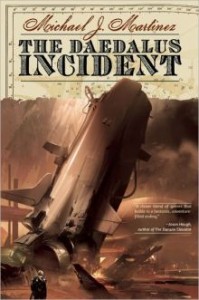 I love a good genre mashup. Elves in the 1940s? Awesome. Cybernetic werewolves? Bring it. Steampunk dragons? You bet. Horatio Hornblower in space?
I love a good genre mashup. Elves in the 1940s? Awesome. Cybernetic werewolves? Bring it. Steampunk dragons? You bet. Horatio Hornblower in space?
…actually, I wrote that, more or less. Crashed a frigate into Mars and everything. Anyway.
Take your favorite sci-fi and fantasy subgenres, critters and tropes, write them on 3×5 cards and shuffle the deck. Chances are, when you draw two, you’ll end up with a whiz-bang clash of genre goodness. Unfortunately, turning that pairing into a setting, let alone a piece of fiction, isn’t quite so easy.
When you combine different genres, you have as much potential for an unholy mess as you do for greatness. It may sound good (“Dude…cybernetic werewolves!”) but I would suggest that it’s harder in some ways to create a mashup than to stick to one particular genre and make it your own.
Readers, I’ve found, are exceptionally and, at times, annoyingly perceptive. When something doesn’t make sense, their antennae twitch. Some can’t keep suspending their disbelief and have to put down the book. Others will keep reading, but look for more errors along the way, and may even take issue with stuff you’ve meant to put there. Two (or more) disparate genre elements can create a lot of potential for twitchy antennae.
Thus, genre mashups may start with an “ah-ha” moment and an aura of geeky awesomeness, but getting them to stand on their own requires discipline and diligence. This is where traditional world-building techniques come into play, but with special attention to the mashup elements. So you have cybernetic werewolves…OK, awesome. What happens to the hardware when they change? Do they have the mental capacity to use advance tech in their wolf-man state? Who, exactly, had the insane notion of rigging up a werewolf (a ’ware-wolf?) in the first place?
When I created the settings for The Daedalus Incident, I asked a ton of questions like those, often with answers leading to multiple additional questions. And as I wrote, I was careful to note other problems and disconnects as they arose, so they could be dealt with all together, at the same time, so that there’s a continuity of setting.
Now, I would say perhaps only 50% of that fully fleshed-out setting is in the book…but I’ve plenty of fodder for the next ones.
And of course, setting is only part of it. One of the mistakes I see in some genre mashups is that it’s enough to have a very cool mashup setting…sometimes at the expense of plot and character. Of course, any good book needs to have strong characters and a well-developed, well-executed plot. The mashup can’t serve as a crutch to prop up the other two.
Likewise, the plot and characters need to interact with the setting organically. You can certainly overlay a noir detective plot over an urban fantasy setting, but that’s not entirely original, now is it? How do the particulars of your mean-street faeries and vampires feed into that noir plot?
The point is, you have to stand strong against the geeky aura and do the hard work. People will expect a lot from a genre mashup – either because they love the idea, or because they think it’s a gimmick and it’s up to you to prove them wrong. The intensity and depth of your world-building after your ah-ha moment – and your plot and characters – will determine whether or not it turns into something great.
 Michael J. Martinez is the author of The Daedalus Incident, coming this summer from Night Shade Books, and is serializing his novella, The Gravity of the Affair, on his blog at michaeljmartinez.net.
Michael J. Martinez is the author of The Daedalus Incident, coming this summer from Night Shade Books, and is serializing his novella, The Gravity of the Affair, on his blog at michaeljmartinez.net.
